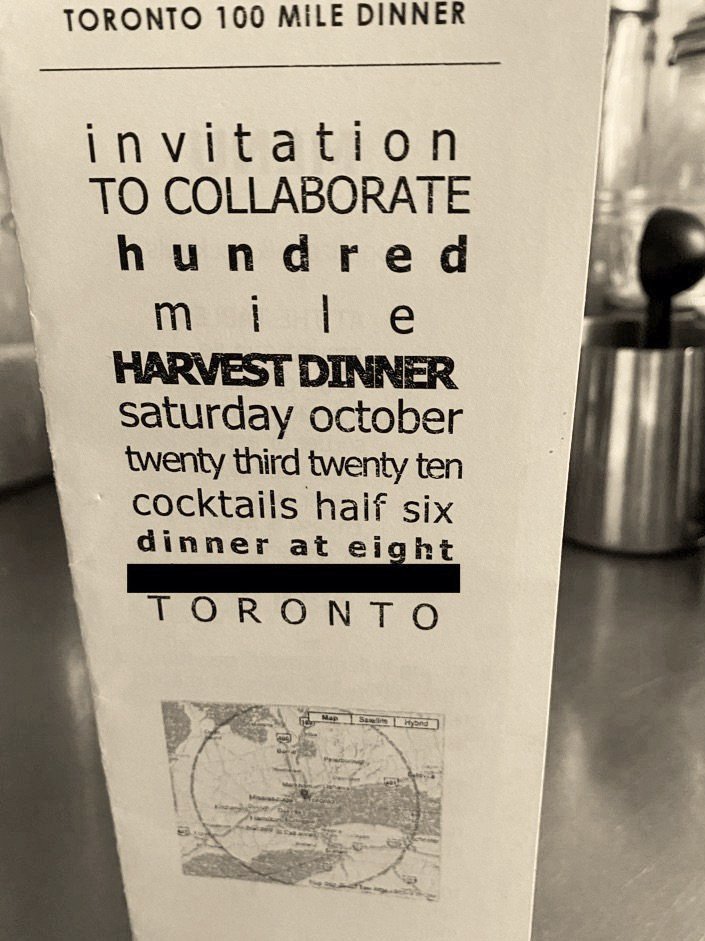It’s the 15th anniversary of the publication of the book 100-mile diet: a year of living locally by Vancouver based authors Alisa Smith and J.B. MacKinnon. Remember how the authors spent a year eating only what they could scare up from within 100 miles (well, with a few exceptions). They began their diet in 2005 and their journey was serialized in The Tyee before the book came out in 2007.
Initially, they lost weight and were out of pocket.
Imagine. No olive oil. No chocolate. No coffee. Smith and MacKinnon started their experiment in the spring and found it rough finding a variety of foods to eat before the spring crops. Following this diet resulted in an initial loss of weight for the two, and a dent in their bank accounts as they switched from a mostly vegan diet to one featuring locally fished salmon, shellfish, and boutique organic cheeses, which proved a little more costly than beans, rice and tofu.
Inspired, I hosted a 100-Mile Harvest Dinner.
Inspired by the book, I elected to try this radically local approach for a single meal. And I also chose the easiest time of year: Harvest time. Still, it was a challenge and I learned a lot.
I ended up hosting a series of 100-Mile Harvest Dinners and in addition to having some wonderful meals, we also learned a lot about what was to be found locally and what was not. I started off inviting 16 guests to collaborate with me on a 100-mile dinner party. Often though we had 20 or more at the table! There was a lot of enthusiasm for participating.
Inside panel of the 100-Mile Harvest Dinner invitation. Menu, Rule and Marco Polo Clause.
I suggest assigning two people to each course except the amuse-bouche and the sorbet, portions of which are sufficiently small as to not be too onerous to prepare for the whole crowd. Remember that each person has to bring something to drink that pairs well with their dish. At the table, I would ask each person to introduce their dish beverage pairing, and if your budget extends to it, I recommend hiring two people to help bussing the plates between courses and possibly washing dishes and cutlery. I have a lot of dishes, cutlery and glasses and I still had to borrow from neighbours and still had to run the dishwasher on the short cycle to keep up with the number of dishes for this long dinner. (I also borrowed chairs.) I lined my two dining tables end to end so that we could sit together at one long table. If you need table cloths that fit such a long table, consider buying cheap white cotton sheets either for under your table protector or if you double them up then you’ve got a great, elegant white table cloth and one sheet for underneath to protect the table. I needed four single sheets to cover the length of the two tables.
Help your guests with an informative invitation
The invitation is key. I included a map of the 100 mile radius of Toronto, as well as:
• sources for ingredients, with links if you do an email version
• the rule and the exception clause
• the menu and course assignments.
• a map with your city/town in the centre of a circle with 100 mile radius.
Each of 16 or 18 guests was asked to prepare a course. Those who pleaded that they were all thumbs in the kitchen were assigned table decorations, or cheese and fruit courses. Each person had to prepare their dish for only 8 or 9 people so that for most courses we had a choice of two different dishes. This made it easier for people with food restrictions to navigate the meal.
When extra diners were added (always ahead of time), I assigned them either to the canapés and cocktails course or to the desserts course.
Cover of a double-sided three panel card invitation to a 100-mile Harvest Dinner for Oct. 23, 2010.
Rule: All ingredients (and their ingredients) must be sourced from within 100 miles.
The first few dinners, we were very strict. All the foods and their ingredients, all the drinks, flowers, and even the candles had to come from within 100 miles. This ruled out olive oil, spices like cinnamon and black pepper, and lemon juice. It also ruled out some “local” cheeses made with milk powders from abroad, and locally baked breads with grains from the prairies.
“Marco Polo Clause: Small pinches of soupçons of spices, oils and citrus could be used if it was reasonable to imagine Marco Polo traded them on his ships. ”
Subsequent years, we invoked what I called the Marco Polo Clause. You could use a pinch of ginger or black pepper or a splash of olive oil, or a dash of whatever you could imagine Polo traded and carried on his ships. Marco Polo traded apples, for instance, and they were not allowed. Apples had to be local; the cinnamon could come from Sri Lanka.
Choose your number of guests and courses. I recommend 16 guests and depending on how many guests, I chose the number of courses from the following courses:
cocktails and canapés
amuse bouche
soup
small plate (pastry, paté, etc)
fish
sorbet
main course
sides
salad
cheese and fruit
dessert
Detail of a panel in the six panel invitation for a 100-mile Harvest dinner, 2010
I got a chance to talk about these 100-mile ‘orchestrated potluck’ Harvest dinners in my latest radio broadcast column for CBC Syndication. (I’ll post a link once it airs.)




